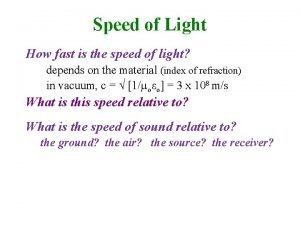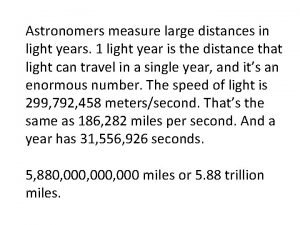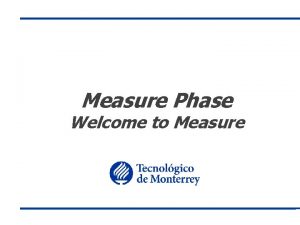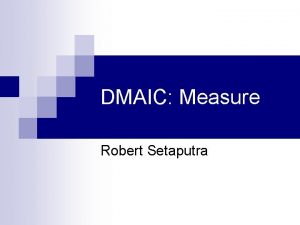Light Light Terminology Which is not a measure









- Slides: 9

Light

Light Terminology Which is not a measure we use to identify a type of light? A. Wavelength B. Speed C. Frequency D. Energy

Speed of Light • Light is made of particles called photons. c = 3 105 km/s = 186, 000 miles/sec • All photons move at a constant speed c in the vacuum of space. 10 -9 s in 1 foot = 1 nanosecond/foot 0. 02 sec to cross the US 8 min to get from the Sun to the Earth

Measuring Waves • Photons can act as waves. • Wavelength ( ) is the distance between two waves. • The period is the time between waves. 1 wavelength • Frequency ( ) is the inverse of the period. – Frequency is measured in hertz (Hz). • Speed, wavelength and frequency are related.

Measuring Particles • Photons can act as particles. • Particles are described by their energy (E). – Measured in joules (J) – Golf ball dropped from 7 ft • Waves are related to particles. • Planck’s Law describes the amount of energy in a photon. – h is Planck’s constant – h = 6. 6 10 -34 J s

Visible Light Wavelength in nm wikipedia • Visible light is radiation in a narrow band of wavelength or energy. – Narrower ranges are colors • Visible light is part of a larger electromagnetic spectrum.

Radio Waves • Radio waves come from electrical oscillations. – Microwaves with shorter wavelengths • The long wavelengths travel easily and are not interfered by atoms. Radio waves > 1 m Microwaves 1 mm to 1 m < 3 x 108 Hz 3 x 1011 Hz to 3 x 108 Hz

Infrared and Ultraviolet • Visible light is often produced by vibrating atoms and molecules. – Infrared lower energy than visible light – Ultraviolet higher energy than visible light Infrared Visible light Ultraviolet 700 nm to 1 mm 400 nm to 700 nm 10 nm to 400 nm 4 x 1014 Hz to 3 x 1011 Hz 8 x 1014 Hz to 4 x 1014 Hz 3 x 1016 Hz to 8 x 1014 Hz

High Energy Photons • X-rays come from energetic transitions in atoms. • Gamma rays come from nuclear and subatomic reactions. X-rays 0. 01 to 10 nm Gamma rays < 0. 01 nm Thinkstock. com 3 x 1019 Hz to 3 x 1016 Hz > 3 x 1019 Hz
 If you can't measure it you can't improve it quote
If you can't measure it you can't improve it quote Sadlier vocabulary workshop level d unit 1
Sadlier vocabulary workshop level d unit 1 Gibbons jacobean city comedy download
Gibbons jacobean city comedy download Barometer
Barometer Light light light chapter 23
Light light light chapter 23 Light light light chapter 22
Light light light chapter 22 Light light light chapter 22
Light light light chapter 22 Measure what is measurable and make measurable what is not
Measure what is measurable and make measurable what is not Inertial frame of reference
Inertial frame of reference Astronomers measure large distances in light years
Astronomers measure large distances in light years

















